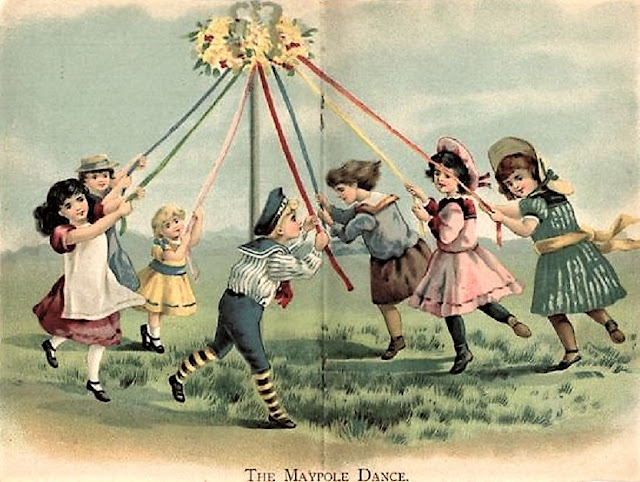
1669 Scene before a Maypole near stages with Alkmaar Church in the Background by Salomon van Ruysdael (Dutch Landscape Painter, 1600-1670). In England, permanent Maypoles sometimes were erected on village greens. In some villages, there also were smaller Maypoles in the yards of households. In ancient European festivals of spring, Beltane, the dance around the Maypole represents their unity with the pole itself being the God & the ribbons that encompass it, the Goddess. Mayday is a festival of flowers, fertility, sensuality, & delight.
This painting is a copy of a painted wooden over-mantle, possibly showing the village of Weybridge c 1699-1701. In this painting, many figures in 18C costume are depicted dancing around a painted wooden maypole. The painting is alleged to show the maypole set up on near the Ship Inn with the High Street in background. Until the late 18C, Weybridge was as a very small village with a river crossing, seed milling to make flour & nurseries which would continue to provide the major source of home-grown income for the village until the 20C.
Josef Frans Nollekens (Flemish-born British artist, 1702-1748) May Day with a Maypole up on the hill. Some festival celebrants believed that on May Eve, you could bless your garden in by making love there with your partner. Union with the land was a May 1 focus, often with actual mating outside on other lands to bless fields, herds, home.
Maypole at a Country Inn by Johann Peter Neeff (1753-1796) Revellers welcomed May at dawn with singing & dancing. Later communities celebrated with Morris Dancers & more formal pageants featuring Jack-in-Green& a May Queen to awaken the fertility in the Land.
1741 The Milkmaid’s Garland, or Humours of May Day, Francis Hayman. In ancient spring-times, gathering & exchanging of Flowers & Greens was common on May Eve. Merrymakers decorated homes, barns, & other buildings with green budding branches. Men & women made garlands & wreaths of Flowers & Greens.
18C Jan Josef Horemans II. (1714-1790) Villagers Making Merry with Maypole in Background. Early communities prepared a May basket by filling it with flowers & goodwill & then giving it to someone in need of healing & caring. Women in early cultures formed wreaths of freshly picked flowers to wear in the hair to radiate joy & beauty.
1767 Printed for Robert Sayer, London. Early groups often danced the Maypole to feel the balancing of the Divine Female & Male within. In Pagan Rome, Floralia, from April 27-May 3 was the festival of the Flower Goddess Flora & the flowering of Springtime. Roman Catholic traditions of adoring statues of Mary with garlands of flowers on May 1 have Roman Pagan roots. On May 1, offerings were made to Bona Dea (as Mother Earth), the Lares (household guardian spirits), & Maia (Goddess of Increase) from whom May gets its name.
Jan Josef Horemans the Elder (Dutch artist, 1682-1759), Spring & Dancing Around The Maypole. On May 1, early cultures followed a pastoral tradition of turning sheep, cows, other livestock out to pasture. In early Scandinavia, mock battles between Winter & Summer were enacted at this time. Maypoles in Spain sometimes were topped with a male effigy which was later burned. In Germany, Fir trees were cut on May Eve by young unmarried men, branches removed, decorated, put up in village square, & guarded all night until dance occurred on May Day.
+May+Day+Scene.jpg)
1761–1770 John Collet (British artist, c.1725–1780) A Satire of a May Day Scene in London. Fire is a common accompaniment to many May celebrations. Celebrants mark the holiday by lighting fires, dancing, feasting & often performing fertility rites. Many built a bonfire & then moved through it or danced clockwise around it. Livestock was driven around a Beltane fire or between 2 fires for purification & fertility blessings.
1800s Robert Walker Macbeth (1848-1910) - Maypole scene depicting an earlier era. In ancient times Druid priests kindled it at sacred places. In later times, Christian priests kindled their spring fires in fields near the church after performing a Christian church service. Branches & twigs often were carried around these fire 3 times, then hung over hearths to bless homes.
Frederick Goodall (British artist, 1822-1904) Here Goodall depicts the Raising the Maypole from an earlier era. Risk-takers made a wish for good luck before jumping a bonfire or the flame of a candle. Some believe during May the veil between the human & supernatural worlds is at its thinnest, making them potent days for magic. Beltane may refer to the “fires of Bel,” in honor of the Celtic sun god, Belenus. Some pagans believe fire has the power to cleanse, purify & increase fertility.
May Day, usually the 1st of May, celebrates the onset of summer, the height of Spring, & the flowering of life. In ancient European festivals of spring, Beltane, the dance around the Maypole represents their unity with the pole itself being the God & the ribbons that encompass it, the Goddess. Mayday is a festival of flowers, fertility, sensuality, & delight.
In Pagan Rome, Floralia, from April 27-May 3 was the festival of the Flower Goddess Flora & the flowering of Springtime.






%2C%2B%2BSpring.jpg)

+Raising+the+Maypole+(2).jpg)






